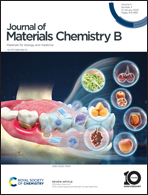Bioactive glass-based organic/inorganic hybrids: an analysis of the current trends in polymer design and selection
Abstract
Bioactive glass-based organic/inorganic hybrids are a family of materials holding great promise in the biomedical field. Developed from bioactive glasses following recent advances in sol–gel and polymer chemistry, they can overcome many limitations of traditional composites typically used in bone repair and orthopedics. Thanks to their unique molecular structure, hybrids are often characterized by synergistic properties that go beyond a mere combination of their two components; it is possible to synthesize materials with a wide variety of mechanical and biological properties. The polymeric component, in particular, can be tailored to prepare tough, load-bearing materials, or rubber-like elastomers. It can also be a key factor in the determination of a wide range of interesting biological properties. In addition, polymers can also be used within hybrids as carriers for therapeutic ions (although this is normally the role of silica). This review offers a brief look into the history of hybrids, from the discovery of bioactive glasses to the latest developments, with a particular emphasis on polymer design and chemistry. First the benefits and limitations of hybrids will be discussed and compared with those of alternative approaches (for instance, nanocomposites). Then, key advances in the field will be presented focusing on the polymeric component: its chemistry, its physicochemical and biological advantages, its drawbacks, and selected applications. Comprehensive tables summarizing all the polymers used to date to fabricate sol–gel hybrids for biomedical applications are also provided, to offer a handbook of all the available candidates for hybrid synthesis. In addition to the current trends, open challenges and possible avenues of future development are proposed.

- This article is part of the themed collection: Journal of Materials Chemistry B Recent Review Articles


 Please wait while we load your content...
Please wait while we load your content...